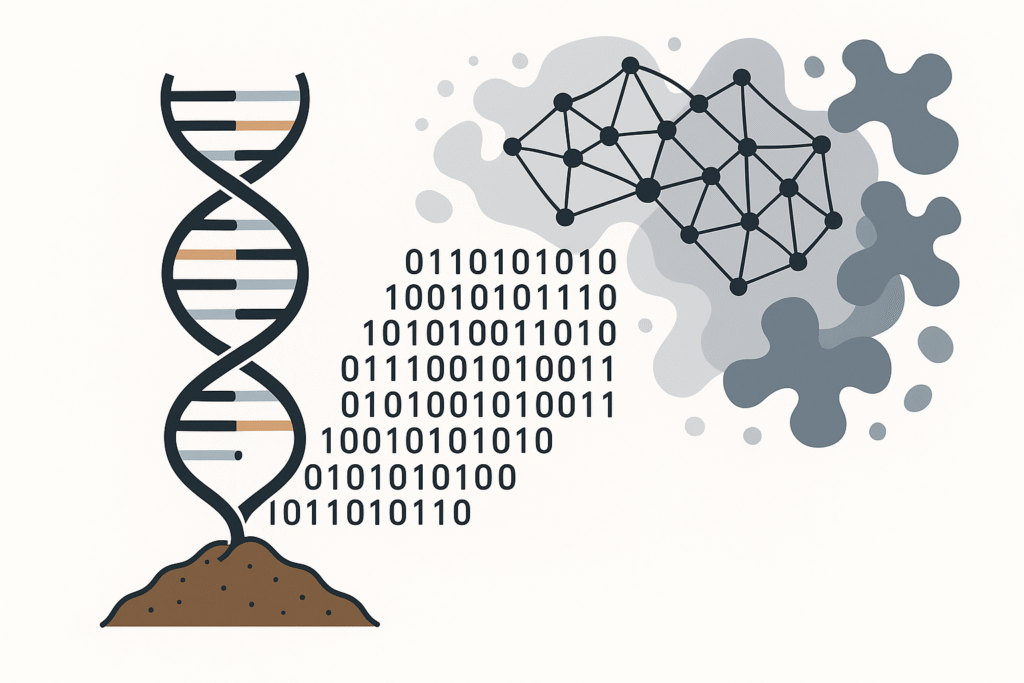By Utsav Dhiman
Alumnus and Former Research Officer, University of Essex, United Kingdom

Hidden within a single gram of soil is a bustling metropolis of life, crowded with more microbes than the total number of humans on the planet. Each of these microscopic organisms contains a genetic script, a swirling database of information carefully sculpted over billions of years. Despite our remarkable advances in technology, much of this script remains undeciphered. Researchers refer to it as the “dark matter” of the microbial world. This is the vast and mysterious expanse of microbial genomes, full of genes whose purposes are still unknown. Today, the rise of artificial intelligence is illuminating this shadowy domain, promising to revolutionize how we explore, understand, and use the microbial universe that quietly supports life on Earth.
The Unseen Majority: Microbial ‘Dark Matter’
When most people think of a genome, they might imagine the well-charted map of human DNA. Microbial genomes, however, tell a far more unpredictable story. Microbes, which include bacteria, archaea, and a host of single-celled life forms, are nature’s ultimate innovators. They flourish in places as varied as steaming hot springs, the deepest ocean trenches, and the frozen crust of Antarctica. Through endless cycles of genetic experimentation, they have adapted to every corner of our planet. Scientists have sequenced the DNA from hundreds of thousands of these tiny pioneers. Still, when this genetic data enters global databases, more than half of the resulting genes cannot be matched to anything scientists have previously studied. These genetic mysteries receive labels such as “hypothetical proteins” or “unknowns.” They float in scientific records like orphans at sea, waiting for someone to unlock their secrets.
This uncertainty is more than a scientific curiosity. The uncharted space in microbial genomes could hold the solutions to some of our most urgent challenges, i.e. developing new antibiotics, creating greener sources of energy, or even building resilience against climate change. The field of microbial dark matter is a true frontier, every bit as intriguing and consequential as the dark matter that puzzles physicists who study the cosmos. Some estimates and my previous encounters with the genomes suggest that more than sixty percent of the genes found in environmental microbes have no clear function assigned. This unknown territory is both a source of frustration and inspiration, reminding us that the world beneath our feet remains largely undiscovered.
The Mystery of Microbial Genes
Why is microbial DNA still so puzzling? The answer lies in the astonishing diversity and flexibility of microbial life. Unlike more complex organisms, microbes often exchange genes with one another, adapt to extreme environments, and evolve at extraordinary speeds. Many species have yet to be grown or observed in laboratories. Traditional scientific methods, which compare gene sequences to known examples or rely on painstaking laboratory work, simply cannot keep pace with the flood of new genetic information arriving from sequencing projects around the globe. Every time researchers map out the genome of a new microbe, they add thousands more unknowns to this growing mountain of unanswered questions.
Much like the invisible dark matter in the universe, these genes are all around us, yet their roles, their contributions to the web of life, and their potential value to humanity remain hidden from view.
Artificial Intelligence Joins the Hunt
In recent years, artificial intelligence has become a powerful partner in this scientific quest. Instead of following the step-by-step logic of older computer programs, today’s machine learning systems analyze vast collections of data, discovering patterns that would escape even the most attentive human eye. In the world of microbial genomics, this shift is transforming what researchers can accomplish.
Modern deep learning models, many inspired by the language-processing tools that decipher text, now read DNA and protein sequences with remarkable insight. These models look for structure, syntax, and hidden rules similar to a reader searches for meaning between the lines of a complex novel. The launch of AlphaFold in 2021 was a landmark moment, as this AI tool demonstrated an uncanny ability to predict the three-dimensional structures of proteins from their genetic codes, solving a scientific puzzle that had challenged researchers for decades. AlphaFold marked only the beginning of this new era. Today’s AI systems are being trained on enormous datasets, sometimes including billions of protein sequences, to predict not only how proteins fold but also how they function, interact, and evolve.
Shedding Light on Genomic Shadows
What, in practical terms, can artificial intelligence reveal about the dark matter of microbial genomes? The results have been astonishing. AI now predicts the shape of proteins encoded by previously mysterious genes. Protein structure is often the best clue to a gene’s purpose. Sometimes a subtle fold or twist hints that the protein can bind to DNA, break down environmental toxins, or produce life-saving antibiotics. Through this lens, AI-driven structure prediction has uncovered whole new families of microbial proteins, some of which are likely involved in unique forms of metabolism or resilience to environmental stress.
Artificial intelligence is also beginning to assign possible roles to those long-ignored hypothetical proteins. By examining patterns in how genes are arranged, the domains within proteins, and how genes appear together in different environments, these systems offer predictions that scientists are now confirming in the laboratory. One striking example involved AI-guided mining of soil bacterial genomes, which uncovered gene clusters that produce entirely new antibiotics. In at least one case, this led to the discovery of a compound effective against antibiotic-resistant bacteria, an achievement that would have taken much longer using traditional research.
Perhaps most significantly, AI is revolutionizing metagenomics, which examines all the DNA in an environmental sample, whether from soil, ocean water, or the human gut. AI tools now rapidly assemble new microbial genomes from massive genetic datasets, piecing together which organisms are present and what they might be doing. These insights are helping scientists to predict which microbes are crucial for carbon cycling, plant health, or even buffering the impact of climate change.
Caution: Navigating the Hype and the Unknown
It is important to recognize that artificial intelligence does not provide all the answers. Machine learning systems are only as good as the data they consume, and existing databases still favor microbes that are easier to study. Sometimes AI predictions remain difficult to interpret or prove in real life. This is why validation in the laboratory is so important. Only by growing the microbes, testing the proteins, and measuring actual outcomes can researchers confirm what algorithms suggest. The scientific community is working to improve the transparency of AI models and to guard against unintentional biases in training data.
A New Frontier in Science and Technology
Looking ahead, many experts believe that artificial intelligence will help unravel the mysteries behind most of the unknown genes in microbial databases within the next decade. This progress could open the door to new industries based on “digital bioprospecting” i.e. the search for valuable biological traits using only computational approaches. Imagine being able to predict, using only data, how a microbe might clean up pollutants or manufacture biofuels, without ever needing to grow it in the lab.
The possibilities go even further. With AI, scientists are beginning to simulate entire microbial ecosystems, forecast their responses to environmental changes, and design synthetic organisms with custom-made abilities. This technology is expanding our vision, offering the chance to solve complex challenges on Earth and perhaps, someday, on other planets.
From Mystery to Opportunity
The unfolding story of microbial dark matter is, at its heart, a story of human curiosity and ingenuity. Artificial intelligence is transforming the unknown into the knowable, offering glimpses of a microbial universe rich with promise and possibility. Every breakthrough blurs the line between what we know and what we can achieve.
For researchers, innovators, and anyone concerned about our planet’s future, this new frontier holds real promise. Somewhere within the dark matter of microbial genomes may lie the solutions to some of our greatest challenges and the inspiration for the next great leap in science.


